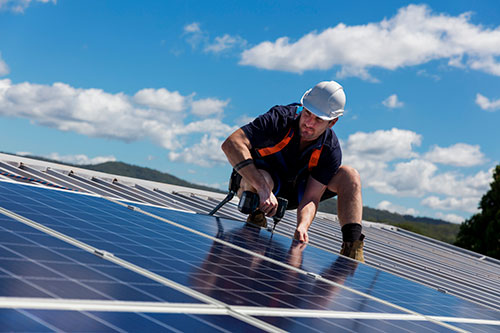Solar power can be a big selling point that can help differentiate a new home from similar inventory. But, is it worth the expense? Here’s what builders need to know about adding solar panels to their design plans.
Incentives and rebates can offset costs.
Although solar power can increase the cost of a home, this can be largely reduced through incentive and subsidy programs. There are a variety of options available through federal, state and local sources, including a 30-percent federal tax credit. Many electric companies also offer incentives and subsidies for solar power.
Solar power increases buyer interest.
According to research from Berkeley Lab, homeowners are willing to pay a premium for properties with solar power, shelling out an average of $15,000 extra for homes with average-sized solar arrays. According to other research, there is a strong correlation between how much a buyer is willing to pay for a home and the size of the property’s solar system. There is also only a weak correlation between premium size and the age of a system, indicating that solar power continues to pique interest for years after installation.
Solar-powered homes tend to sell faster.
According to research, homes tend to spend less time on the market when they are equipped with solar power systems. One study found that California properties with energy-efficient features sell quicker compared to homes that consume more energy. Another study found the same results in the Denver housing market.
Some areas have solar-ready ordinances.
Throughout the country, more and more local governments are creating ordinances designed to ensure that homeowners can easily install solar once construction is completed. These ordinances can vary significantly, depending on the municipality, with some requiring homebuilders to meet a minimum set standard for new construction, and others merely offering best practices and incentives to facilitate for future installs of solar. Common requirements include east-west home arrangement standards to optimize rooftop solar potential; large southern-facing windows for passive heating and the inclusion of dedicated attic pipes and wiring to support potential solar hot water systems.
California recently passed legislation requiring solar panels for all new homes and multi-family residences of three stories or fewer. The move highlights how rooftop solar, once just a luxury for green-leaning wealthy homeowners, is becoming more of a mainstream energy source that is not going away anytime soon.
Making it work for you
Solar power is a great way to boost interest in new homes, especially in regions where sustainable energy is in vogue. Unfortunately, many homebuilders are unsure of how to effectively market solar systems and navigate the installation process. As consumers increasingly choose solar to meet their energy needs, builders must solve these challenges to stay competitive in a shifting landscape. This comprehensive information guide from Sandia National Laboratories is a great resource that can show homebuilders how to integrate solar into new homes to attract more customers and increase their bottom lines.
Protect your business and attract more interest in your homes with 2-10 Structural Warranties for Home Builders. Learn more today!








